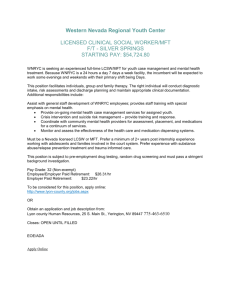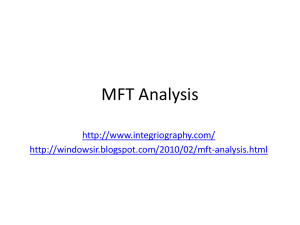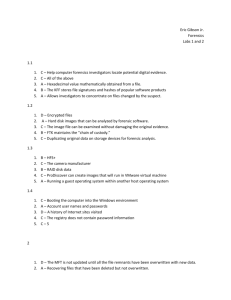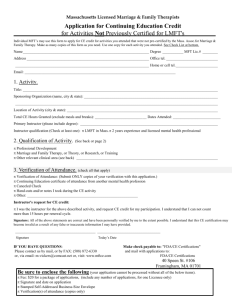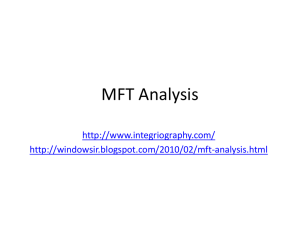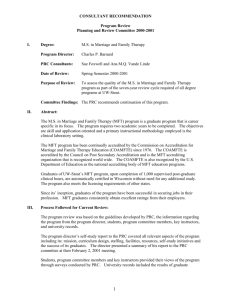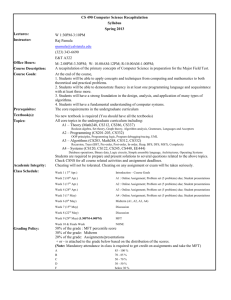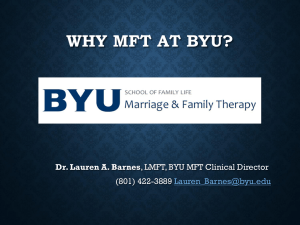1 Program Director Self-Study Report
advertisement
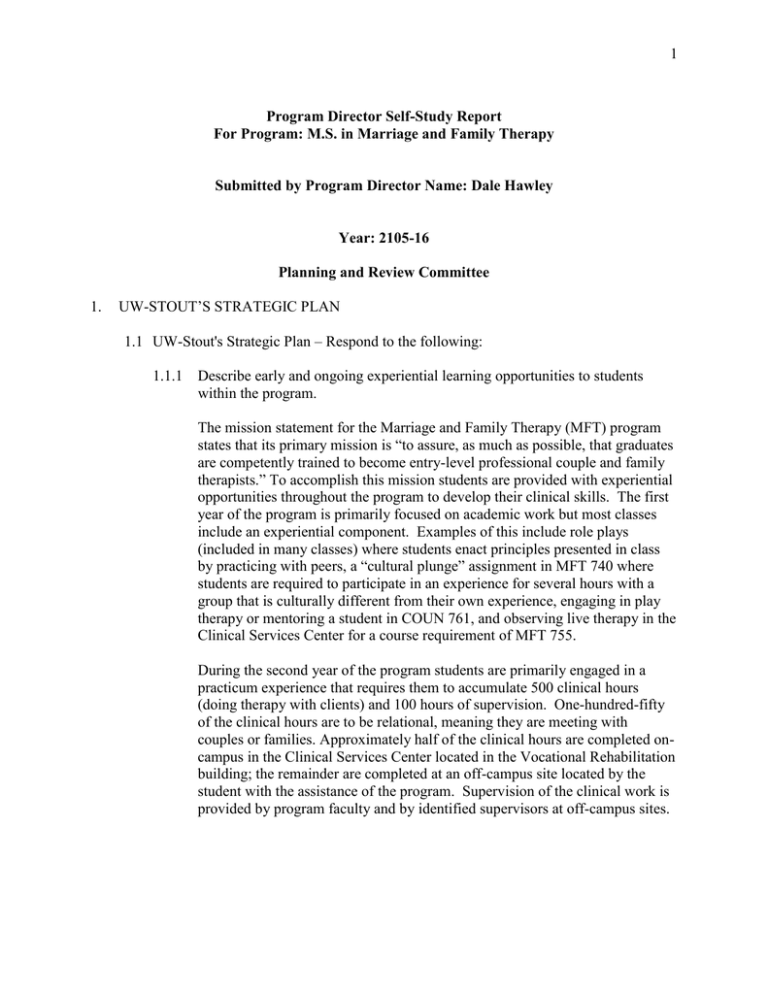
1 Program Director Self-Study Report For Program: M.S. in Marriage and Family Therapy Submitted by Program Director Name: Dale Hawley Year: 2105-16 Planning and Review Committee 1. UW-STOUT’S STRATEGIC PLAN 1.1 UW-Stout's Strategic Plan – Respond to the following: 1.1.1 Describe early and ongoing experiential learning opportunities to students within the program. The mission statement for the Marriage and Family Therapy (MFT) program states that its primary mission is “to assure, as much as possible, that graduates are competently trained to become entry-level professional couple and family therapists.” To accomplish this mission students are provided with experiential opportunities throughout the program to develop their clinical skills. The first year of the program is primarily focused on academic work but most classes include an experiential component. Examples of this include role plays (included in many classes) where students enact principles presented in class by practicing with peers, a “cultural plunge” assignment in MFT 740 where students are required to participate in an experience for several hours with a group that is culturally different from their own experience, engaging in play therapy or mentoring a student in COUN 761, and observing live therapy in the Clinical Services Center for a course requirement of MFT 755. During the second year of the program students are primarily engaged in a practicum experience that requires them to accumulate 500 clinical hours (doing therapy with clients) and 100 hours of supervision. One-hundred-fifty of the clinical hours are to be relational, meaning they are meeting with couples or families. Approximately half of the clinical hours are completed oncampus in the Clinical Services Center located in the Vocational Rehabilitation building; the remainder are completed at an off-campus site located by the student with the assistance of the program. Supervision of the clinical work is provided by program faculty and by identified supervisors at off-campus sites. 2 1.1.2 Describe program initiatives employed to support and/or increase student enrollment, retention and graduation rates? The MFT program has a long history that has helped it develop a loyal base of alumni and a strong reputation in the region. Due to these factors, the program regularly receives considerably more applications than people who are invited to campus for an interview and who eventually matriculate into the program. This past year we have sought to increase our potential pool of applicants by making use of the Hobson’s recruiting tool. Retention and graduation rates in the program are high. Since the last PRC report in 2008 the MFT program 87 students entered the program. Of these, seven did not continue in the program after the first year, a retention rate of 92%. During this same time period 99% of students who continued into the second year of the program graduated; 96% graduated within two years, the minimum advertised length of the program. The MFT program does not have any specific initiatives designed to increase retention and graduation rates. However, based on feedback from graduates and applicants alike several factors seem to contribute to this consistency. Size of the program. As a rule, the program accepts 13 students per year. This allows for reasonable class sizes and personalized attention from faculty. Both the cohort model and the on-campus clinic (mentioned below) are directly related to the size of the program. Cohort model. The program uses a cohort model wherein students entering together take all their courses together, including their practicum experience. They are able to build a learning community that reflects a high level of support for one another. On-campus clinic. As previously mentioned, about half of students’ clinical hours are completed on campus in the Clinical Services center. Of the remaining MFT programs in Wisconsin and Minnesota, only one (Edgewood College) has an on-campus clinic and not all students in that program utilize it. The MFT program at Stout is unique in the region in that students have both an on-campus and off-campus practicum experience. This blends the close supervision of MFT faculty on-campus with the experience of working in a community practice setting. Course scheduling. All courses (with the exception of one summer course and off-campus practica) are offered on Mondays and Tuesdays. This allows the program to widen its range of recruitment beyond students that live in the Menomonie area. Historically the program has drawn a significant number of students from the Twin Cities and Central Wisconsin. This has allowed the program to expand its pool of potential applicants and has helped it be selective in the students who 3 1.1.3 are accepted. Reputation of the program. Over the course of time the MFT program has developed a strong reputation both regionally and nationally. This has helped us recruit high level students that are focused on graduating so they can begin clinical practice. Most applicants are aware that getting into the program is a competitive process and tend to be focused when they enter the program. Describe, provide examples and explain how the program intentionally integrates diversity efforts, functions and contributes to the program in support of Inclusive Excellence: “UW-Stout’s plan to intentionally integrate diversity efforts into the core aspects of everything we do. Diversity is broadly defined and includes, but is not limited to, race/ethnicity, gender, sexual orientation, age and disability status.” The MFT program places a high emphasis in creating a learning environment that values diversity. This is demonstrated in multiple ways: Curriculum. Content focused on diversity is infused throughout the curriculum. One of the core courses in the program, MFT 740, Cultural Competence in the Family, is devoted to increasing cultural awareness through an exploration of the role of power, privilege, and difference in therapy. The course description, objectives, and assessment mechanisms are all focused on issues related to privilege, difference, and inclusivity. In addition, eight of the remaining courses in the program identify objectives, assignments, or class activities that directly address diversity. Our recent accreditation self-study (October, 2014) prepared for the Commission on Accreditation for Marriage and Family Therapy Education (COAMFTE) reported on eleven items asking about preparation in the area of diversity in the annual exit survey completed by graduating students. Mean scores from items relevant to cultural diversity from graduates all fell between “Well prepared” and “Highly prepared” suggesting that in the area of diversity the curriculum is judged by graduates to be effective in preparing them for entering the field of marriage and family therapy. Student composition. The Program Manual reflects UW-Stout policy by stating that the program seeks to provide equal opportunity to all persons regardless of race, color, sex, creed, age, ancestry, national origin, sexual orientation, gender identity/expression, political affiliation, marital status, disability or arrest or conviction record in its education programs, activities and employment practices (p. 3). We do not have data on all these variables but the Graduate School application collects data on three race/ethnicity, age, and gender – which we use to assess difference among our cohort. The 2014 accreditation report found that 23% of students reported a racial/ethnic identity other than White and that 23% identified as male and 77% identified as female. Students ranged in age from 23 to 4 1.1.4 58 with a mean age of 33.4 (sd = 12.2). While there is certainly room to increase diversity in the program both in areas currently assessed and in those not measured, these metrics show greater diversity for race/ethnicity and age range than the university as a whole as well as greater diversity for gender than the composite of other graduate mental health programs at Stout. Faculty and supervisors. The program also seeks diversity in faculty and supervisors. Two indicators currently measured are race/ethnicity and gender. The 2014 accreditation report indicates that 18% of faculty and supervisors identify as a race/ethnicity other than White and that 52% identify as female while 48% identify as male. Both of these metrics are consistent with other accredited MFT programs in the country according to data published on the American Association of Marriage and Family Therapy (AAMFT) website. Applicant screening. The program prioritizes diversity in the screening process by inviting all qualified applicants who self-identify in an ethnically diverse category and/or as a gender other than female (since the majority of students in the program are female) to an on-campus interview (“qualified” is defined as applicants who meet general university standards and specific program standards for admission). In addition, the interview each applicant has with faculty includes an item that specifically inquires about their experience with people from diverse backgrounds. The goal of the program is to accept as many qualified applicants identifying from diverse backgrounds into the program as possible. In the screening and interview process reported in the 2014 accreditation report, of the six students identifying from racial/ethnic groups other than White, five were extended invitations to interview (83%), four were invited to the program (67%) and three accepted (50%). Regarding gender, six students identified as a gender other than female. Five were extended invitations to interview (83%), four were invited to the program (67%) and three accepted (50%). Describe environmental sustainability initiatives embedded and supported by the program: “UW-Stout’s attempt to make students, faculty, and staff more aware of the importance of sustaining our environment through energy conservation, waste reduction, and other measures that will not bring harm to the environment, and to provide students with innovative research opportunities in these areas.” The MFT program seeks to support the University goal of sustainability. Courses use D2L for class materials and assignments to reduce the use of paper. Recordings done in the Clinical Services Center as part of the practicum are now digitized. All classes are held on Monday and Tuesday. Since most students live outside of Menomonie (including a substantial number in the Twin Cities) this helps reduce the carbon footprint by lowering the number of trips students make to campus. 5 2. DESCRIPTION OF THE PROGRAM 2.1 Curriculum Design – Respond to the following: 2.1.1 State the approved program objectives. In keeping with our accreditation guidelines, the program has program, student learning, and faculty outcomes. They are as follows: Program Outcomes 1. Students will successfully complete the Marriage and Family Therapy program at UW-Stout. 2. Alumni will successfully transition from the graduate program to becoming practitioners of couple and family therapy. 3. The program will foster an environment that recognizes privilege and difference and values inclusivity. 1. 2. 3. 4. 1. 2. 3. 4. 2.1.2 Student Learning Outcomes Students will comprehend theoretical concepts underlying couple and family therapy including models of family therapy, dynamics of family interaction and human development, treatment of abuse, diagnosis, psychometric testing, and basic research principles. Students will exhibit clinical skills necessary for the practice of couple and family therapy including the use of self in therapy, clinical assessment and diagnosis, treatment planning and management, assessment of potential for harm to self or others, and therapeutic intervention. Students will demonstrate an awareness of power, privilege, and difference within therapeutic and supervisory contexts. Students will demonstrate an applied knowledge of ethics, legalities, and professional standards related to the practice of couple and family therapy. Faculty Outcomes Core faculty will meet university expectations in the areas of teaching, scholarship, and service. Faculty will demonstrate competence in the teaching of MFT students. Supervisors will demonstrate competence in the supervision of MFT students. Core faculty will contribute to their profession and their community. Describe processes and initiatives employed in determining the need for program revision? The need for program revision is reviewed informally on a continual basis and formally through accreditation processes. Core faculty meet on a bi-weekly 6 basis to discuss issues related to the program. Discussion about revisions to the curriculum or program policies are a regular part of these meetings. Examples of revision occurring in the last year as an outcome of these meetings include a review of all courses to determine areas where areas of overlap may be occurring, revising procedures for the interview process for applicants, and implementation of an orientation for incoming students. In each case discussion among faculty identified gaps in the program that needed to be filled and actions were taken to address these gaps. As previously mentioned, the MFT program is accredited by COAMFTE. As part of the accreditation process the program is required to do a self-study and host a site visit from representatives of COAMFTE who review the program. Revisions were made to the program as part of the self-study process to meet accreditation guidelines. Examples include updating educational outcomes, identifying benchmarks for determining whether the outcomes are being met, and establishing a student governance committee. The program should receive a report in December, 2015 regarding their accreditation status. In the event there are stipulations (a common occurrence with COAMFTE) the program will act to address them. In addition, COAMFTE recently updated its standards and the program will need to make curricular changes to meet the new standards over the next two years. 2.1.3 Check all that apply regarding the program: _ _Traditional, on campus program ___Offsite location ___Online program x Non-traditional, on-campus program The MFT program does not fit any of the existing categories. It is an oncampus program but is non-traditional in that it meets only Mondays and Tuesdays and attracts a cohort of students from around the state and the Twin Cities that commute to campus. It also attracts an older than average student base. The non-traditional nature of the program is a primary reason the MFT program has been approved to move to a CI model. 2.1.4 Briefly describe the components of your program where students participate in scholarly activity such as: research, scholarship, experiential learning and creative endeavor. “programs are presented through an approach to learning which involves combining theory, practice and experimentation” (UW-Stout’s Mission Statement) Several of the courses in the curriculum require students to explore relevant scholarly literature to complete a course project. For example, MFT 750 (Foundations of Family Therapy) requires students to identify a population they envision working with (e.g., couples, adolescents with eating disorders, etc.) and a theoretical model they would use. They are to describe how they 7 would work with someone from this clinical population using the selected model by drawing on scholarly literature that integrates both. A number of courses have similar projects. All students complete a research methods course (MFT 765). A goal of this course is to help them become adept consumers of research so that their clinical work is empirically informed. However, students also complete an empirical project as part of the course requirement which gives them experience with the process of doing research. In addition, a number of students elect to complete a Plan B project as part of their program. Typically, these are students who aspire to do doctoral work. All students complete a practicum which requires them to meet with clients for a minimum of 500 hours. This is a highly experiential component of the program. During the program students learn to apply theoretical principles learned in the classroom to the real life circumstances of the clients whom they are serving. Approximately half of these hours are completed in the on-campus clinic used by the program (the Clinical Services Center) with the other half completed at an off-campus practicum site in the student’s community. 2.1.5 Does your program currently have an accreditation or certification agency that reviews the program? If so, which agency and to what extent does it influence the structure of the curriculum? The MFT program is accredited by the Commission on Accreditation for Marriage and Family Therapy Education (COAMFTE). The program is currently under review, having submitted a self-study in October, 2014 and hosted a site visit in March 2015. Results of the review should be made available to the program by December, 2015. COAMFTE has a major impact on the structure of the curriculum. An important goal of the program is preparing students for licensure as a marriage and family therapist (Program Outcome 2). Students who graduate from a COAMFTE approved program automatically meet the educational requirements for licensure in most states, including Wisconsin and Minnesota. Thus, meeting COAMFTE curriculum requirements plays a major role in the structure of the curriculum for this program. 2.2 Faculty/Academic Staff Expertise – Respond to the following: 2.2.1 List key instructors in the program. A key instructor is one who teaches at least one required professional course in your program (this should be the combined faculty of Key A and Key B who were surveyed by the PRC). Dr. Markie Blumer (MFT 752, 765, and 793-795) Dr. Kevin Doll (HDFS 742) Dr. Dale Hawley (MFT 750, 755, and 793-795) 8 Dr. Alex Iantaffi (MFT 752 – Fall 2015, adjunct) Dr. Terri Karis (MFT 740, 745, 751, and 793-795) Dr. John Klem (COUN 723 and 761) Kelly Lamon (COUN 761) Dr. Anne Ramage (MFT 744 and 793-795) Dr. Bob Salt (HDFS 715) 2.2.2 What additional faculty/academic staff expertise is needed? The curricular needs of the program are being met by the current faculty/academic staff. Core faculty in the program teach the MFT courses (with the exception of Dr. Iantaffi, an adjunct instructor who is currently teaching MFT 752 in place of Dr. Blumer). Drs. Blumer, Hawley, and Karis are tenured/tenure track faculty; Dr. Ramage is in an academic staff position. Each of these faculty are experienced therapists and AAMFT Approved Supervisors, a requirement for accreditation. The core faculty was formerly composed of four tenured/tenure track positions. Since 2003, when a position opened up by a retirement was not filled, academic staff have taken on the responsibilities of the fourth faculty member. The University has been supportive of this arrangement over the past 12 years and, as long as that support remains and we are able to fill the academic staff position with a person of Dr. Ramage’s caliber, it does not present a concern. If this situation were to change, the program would need a fourth tenure track position. Other faculty who instruct in the program (Doll, Klem, Lamon, and Salt) teach courses that are required in the curriculum. These courses allow the program to fulfill accreditation requirements and prepare students for state licensure as marriage and family therapists. The program is preparing to move to a Curriculum Instruction model. Several courses in the program are currently shared with other programs (MFT 751, COUN 723, COUN 761, and HDFS 742). At this point other programs that also utilize these courses are not planning to move to a CI model. This means the MFT program will need to develop separate CI sections. This is not a concern for MFT 751 and HDFS 742 because multiple sections are currently offered and one could be converted to a CI section. It does present an issue for COUN 723 and COUN 761. It may mean that CI sections will need to be created for these courses. In this event the program will need to find suitable instructors for these sections. 2.3 Facilities – Respond to the following: 2.3.1 Describe facilities and or capital equipment currently used and how it supports or strengthens the program? What program specific facilities (unique 9 classrooms, labs, additional space involving minor construction) have been requested and provided? Aside from space and equipment the University provides for individual faculty (e.g., office and laptop), the MFT program primarily makes use of three spaces: the Clinical Service Center (CSC), Voc Rehab 344, and a computer lab (Voc Rehab 242). The CSC is a lab shared with other programs (Clinical Mental Health Counseling, School Psychology, and School Counseling). It serves as the location where students complete the on-campus portion of their practicum (MFT 793-795). The CSC includes ten interviewing rooms equipped with one-way mirrors for observation plus a large room used primarily for classes and processing of cases. The MFT program primarily uses five of these rooms from 1:00-9:00 PM on Mondays and Tuesdays (Mondays only during the summer) although they occasionally use other interviewing rooms in the clinic during times of heavy usage. The CSC has a state-of-the-art digital recording system (installed in 2014) that allows students to record all sessions they conduct. Each room in the CSC is equipped with two cameras except for the room where the server and connected computers used for scheduling recordings are housed. Voc Rehab 344 serves multiple purposes for the program. It is used for weekly staffings, faculty meetings, interviewing applicants, and seminar classes (which has been especially important during the Harvey Hall construction project). It also houses the program library. The computer lab is shared with the School Psychology program. It houses several computers that can be used for case documentation, testing, and research on cases. 2.3.2 What added facilities needs (if any) such as unique classrooms, labs, additional space involving minor construction exist in the program? There is a critical need for a separate room to house the computers used for scheduling and reviewing sessions in the CSC. The computers are currently located in the same room as the server. Sessions can be scheduled in this room but, due to the noise of the server, they cannot be reviewed. In order to review sessions they have recorded, students must download them to a flash drive and play them on their personal computers or in the computer lab. This presents concerns related to confidentiality. Instead of being able to view sessions directly from the system, sessions have to be downloaded to storage devices that can be removed from the campus. A separate room in close proximity to the CSC would allow students to review sessions in a place more conducive to learning. Such a change would benefit all programs that use the CSC. 2.4 Resources for the Program – Respond to the following: 10 2.4.1 Evaluate the quality, relevance, and quantity of the library resources to support the program. Include a brief statement as to how these needs have been met by the library. The library has an excellent collection of MFT related material including books, videos, DVDs and journals. Students and faculty alike utilize the resources made available by online data bases such as PsychInfo. Of particular value has been the recent addition of Psychotherapy.net which contains a number of recordings that demonstrate the various types of therapy taught in the program. Library staff have been very accommodating. For the past several years they have provided an orientation to library services and data bases for our incoming students. The textbook rental service has also been excellent in responding to requests from program faculty for course resources. For example, as new editions of textbooks have been requested for courses over the past several years all have been filled. Finally, the library continually reaches out asking about resources that could be added to their collection which would benefit the program. They have been responsive to our requests. 2.4.2 List any special resources used to meet program and/or student needs such as: Learning Technology Services for curriculum materials development, ASPIRE, Research Services, Advisement Center, Disability Services, Multicultural Student Services, etc. In the recent self-study for COAMFTE students (n = 24) were surveyed regarding which student services on campus they used. The following student services were identified: Counseling Center, Financial Aid office, Library, Multicultural Student Services, Office of International Education, the QUBE, Student Health Services, Technical Communications, and the Writing Center. Services utilized by the most students were the Library (23), Financial Aid (12), and the Counseling Center (9). Satisfaction with the services ranged from 3.0-4.0 on a four-point scale (4 being the high score). The survey contained a fixed list of student services and likely did not include some used by students. For example, although it was not on the list some students did access Research Services in developing IRB protocols for their Plan B papers. It should also be noted that these results are from students in the program in 2014-15. Students in other years may have utilized other services. In addition, the program has worked with University Communications to find ways to connect with the public regarding therapy services offered through the Clinical Services Center. They have been helpful in sending press releases regarding special initiatives and in making the clinic website more accessible to the public. 2.4.3 Describe other resources (if any) needed to meet the program objectives? None at this time. 11 3. Quality of the graduates of the program – Respond to the following: 3.1 Describe program graduate demand and/or anticipated changes or trends impacting the future demand. The US Department of Labor projects a 29% employment growth for Marriage and Family Therapists between 2012-2022 (http://www.bls.gov/ooh/community-andsocial-service/mental-health-counselors-and-marriage-and-family-therapists.htm) which is much faster than the national average. US News and World Report ranks Marriage and Family Therapy #35 among the 100 best jobs. The average age in the profession is in the mid-50’s, so a significant percentage of those currently employed are likely to reduce their hours or retire over this timeframe. While an uncertain economy and shrinking resources may delay retirement for some, the increase in couple and family distress that occurs during difficult economic times will increase the need for MFTs. This may help offset the fewer job openings that may occur due to delayed retirement. It appears there will continue to be a good demand for MFTs. This fits the data produced by our program specific graduate survey which shows that 89% of UW-Stout MSMFT graduates report working in the MFT field. 3.2 Interpret the data provided by the Planning, Assessment, Research and Quality (PARQ) office of the alumni follow-up surveys. Results from three one-year and three five-year alumni surveys conducted by PARQ were found on WebNow. The one-year surveys assessed graduating classes from 2010, 2012, and 2014. Fifteen of 36 surveys were returned for a response rate of 42%. The five-year surveys assessed graduating classes from 2004, 2006, and 2008. Sixteen of 35 surveys were returned for a response rate of 46%. The following descriptions combine data from all surveys for each category. One Year Follow-up Eighty-six percent of the alumni surveyed were currently working; the two alumni who were not working reported they were students. 83% indicated they were working in a job related to their degree including 75% who said their job was directly related. Alumni felt their graduate experience at Stout had equipped them well. Means scores for all assessed areas associated with this item (#3) were between agree (3) and strongly agree (4) with the exception of two items. Alumni felt less prepared in utilizing technology (mean =2.78) and in understanding statistics (2.71). Neither of these areas are a focus for the MFT program. However, two areas that students indicated they felt very prepared for were appreciating and understanding diversity (3.71) and considering ethics of the profession (3.92). Both of these areas are strongly emphasized in the program. Sixty-four percent of students reported that they were “greatly challenged” by the program (mean=3.57). 12 Alumni also expressed a high degree of satisfaction with various aspects of their education, particularly those parts closely associated with the program, They rated the mentorship of faculty (4.0), program instruction (3.79), and faculty availability (3.93) very highly and also indicated that course availability (3.64) and academic advising (3.69) were program strengths. Aspects of their educational experience less closely associated with the program were also generally seen as helpful: library (3.33), technological environment (3.14), lab facilities (3.57), and help with statistics (2.78). It should be noted that with the exception of library services, fewer students responded to these items. Alumni indicated that the program had prepared them well to take on the role of marriage and family therapist. They cited course work (3.5) and their practicum experience (3.93) as especially important factors in their preparation. Eighty-six percent felt they were better prepared than colleagues from other disciplines when they entered the field and 93% reported the overall effectiveness of the program was very high. Finally, alumni appeared to be pleased with their overall experience. Eighty-six percent described the value of their education as exceptional and there was strong agreement that, if they had to do it over, they would attend Stout (3.75) and enroll in the MFT program (3.7) again. Five Year Follow-up Eighty-one percent of the alumni surveyed were currently working. Of those not working one reported being a student and others indicated they were dealing with a disability, were looking for work, or were a fulltime homemaker. All alumni currently working indicated they were working in a job related to their degree including 69% who said their job was directly related. As with the one-year group, alumni felt their graduate experience at Stout had equipped them well. Means scores for most assessed areas associated with this item (#3) were between agree (3) and strongly agree (4) with the exception of three items. Alumni felt less prepared in utilizing technology (mean =2.6), in understanding statistics (2.29), and in preparing a resume/portfolio (2.23). While the former two of these also appeared in the one year follow ups, resume preparation does not. It is now included as part of the Professional Issues course (MFT 755) which may account for why it is not found in later cohorts who were surveyed. Two areas that students indicated they felt very prepared for were appreciating and understanding diversity (3.8) and considering ethics of the profession (4.0). Both of these areas are strongly emphasized in the program. Forty-one percent of students reported that they were “greatly challenged” by the program, with an additional 41% rating the program a three out of four on this item (mean=3.24). Alumni expressed a high degree of satisfaction with various aspects of their education, particularly those parts closely associated with the program, They gave high ratings to the mentorship of faculty (3.63), program instruction (3.63), and faculty availability 13 (3.8). They also indicated that course availability (3.63) and academic advising (3.47) were program strengths. Aspects of their educational experience less closely associated with the program were also generally seen as helpful: library (3.25), lab facilities (3.11), and help with statistics (3.56), although fewer students responded to the last two items. Satisfaction with the technological environment was not rated as highly as other areas (2.5). Alumni indicated that the program had prepared them well to take on the role of marriage and family therapist. They cited course work (3.47) and their practicum experience (3.76) as especially important factors in their preparation. Sixty-seven percent felt they were much better prepared than colleagues from other disciplines when they entered the field and the remaining 33% rated this item three on a scale of four. Sixty-three percent reported the overall effectiveness of the program was very high and the remaining 37% described effectiveness as high. Finally, alumni appeared to be pleased with their overall experience. Sixty-three percent described value of their education as exceptional (mean = 3.56) and there was strong agreement that, if they had to do it over, they would attend Stout (3.73) and enroll in the MFT program (3.67) again. Overall evaluation Response rates were somewhat low for these surveys and inferences made from the data should bear this in mind. Ratings from the five-year evaluations were lower in some areas than the one-year evaluations. This is to be expected. There is often a regression effect the further one gets away from their graduate experience. However, given that these evaluations are assessing different cohorts from the MFT program at two different time intervals, the results are remarkably consistent. Feedback from six different cohorts indicate a high level of satisfaction with the program and suggest that graduates are well prepared for entry into the field. 3.3 Interpret program specific surveys (students, faculty and advisory committee) conducted by the Planning and Review Committee. Student survey Twenty-two of 25 students in the program at the time the survey was conducted responded for an 88% response rate. One response to all questions was strongly negative about the program which does not seem consistent with the qualitative comments or informal feedback from the students to faculty and may indicate the respondent reversed the items in the response set. In general, students appear quite satisfied with the program. Students strongly supported items indicating that program objectives had been met, they felt prepared to enter the field of marriage and family therapy, and they would choose the program again if they had to do it over again (mean scores = 4.41-4.64). When asked to respond to program strengths, several factors repeatedly surfaced: 14 The cohort model. Students in the MFT program enter as a cohort and complete the program together, most within a two year period. The on-campus clinic. Approximately half of the practicum is completed in the CSC with close supervision from faculty serving as supervisors. The faculty. A number of comments cited the excellence of the faculty indicating they are knowledgeable, supportive, challenging, and personable. This was echoed in the quantitative portion of the survey. Professors were seen as providing relevant content in their courses (mean = 4.64) and were described as making themselves available to students (mean = 4.68). A number of other strengths were also identified including an emphasis on diversity, affordable cost, small class sizes, two day a week scheduling, and abundant opportunities to do clinical work. Diversity as a strength was also found in quantitative items: maturing attitudes toward racism and diversity (4.68) and maintaining a global perspective (4.5). There were also a number of suggestions for improving the program. Several themes emerged here as well: Facilities. Some comments indicated the classrooms used were not good learning environments and the clinic could be improved aesthetically. These comments were supported in quantitative items: classrooms providing a good learning experience (3.36) and the lab equipment providing a good learning environment (3.91). Classes. Several suggestions related to courses were offered. These included greater variety in the Couples and Sex Therapy course, more emphasis on substance abuse, more electives, and several suggestions about reordering courses to make learning more effective. These items will be addressed over the next two years as we revise the curriculum. Orientation. A couple comments indicated more needed to be done to orient students to the program. In response to this the program implemented an orientation day prior to the start of classes for the 2015 incoming cohort. Several other suggestions for improvement were made including more funding, an increased focus on research, and having a more systemic focus in some classes. Program Faculty Five of six faculty (not including the Program Director) at the time the survey was conducted responded for an 83% response rate. The faculty appeared to be satisfied with most aspects of the program. They rated the students as well prepared (4.8) and in text responses noted personalized attention made possible by small cohort sizes as a strength of the program. The identified a good working relationship with the Program Director citing good communication (4.8) and satisfactory leadership (4.6) as strengths. Most of the support services (library, clerical, and departmental support; mean = 4.0 - 4.8) were given high ratings. However, classroom quality (3.4) and 15 support for instructional technology including D2L received the lowest scores of any quantitative items. Program Advisory Committee Five of eight members of the Program Advisory Committee responded for a 62% response rate. In general, the committee indicated they were kept informed about the program and that their input was valued. 80% indicated they were informed about student learning data, 100% said the program sought their input, and 80% believed the committee’s recommendations impacted programmatic decisions. Text responses identified size of the program, utilization of two practicum sites, strong leadership, and uniqueness of the program as strengths. One respondent indicated that exploration of some topics in greater detail would be helpful. 40% of respondents thought more meetings of the PAC would be useful and one person commented on this in a text response as well. 4. Program evidence of continuous improvement – Respond to the following: 4.1 Describe program strengths distinguishing it from similar programs. Describe and explain program weaknesses? Strengths The MFT program has a number of strengths that enable it to be highly competitive with similar programs: 1. University commitment. The program is housed in a university that has a strong commitment to MFT training as evidenced by nearly 40 continuous years of COAMFTE accreditation. 2. Size. The program admits an average of 13 students per year. This allows faculty to maintain personal relationships with students, makes it possible to operate an on-campus clinic, and contributes to a successful cohort model. 3. Cohort model. As identified in the student survey, the cohort model utilized by this program wherein students complete classes including practica together creates a supportive learning community that enhances learning. Relatively few of the MFT programs in the region utilize such a model. 4. On-campus clinic. The MFT program has a hands-on approach that requires students to complete at least 500 hours of clinical work as part of their training. While a clinical component is a part of most MFT programs, the program at Stout is distinguished from most other MFT programs in the area because students are able to complete part of their practicum experience in an on-campus clinic where they receive close supervision from program faculty. 5. Two day a week schedule. The on-campus portion of the program is run entirely on Mondays and Tuesdays. This enables students from a wide geographic range to be a part of the program as they are able to travel to campus and stay in Menomonie on Monday evenings. In the past several years the program has had students from 16 the Twin Cities, Duluth, La Crosse, and the Fox River Valley. 6. Excellent faculty. With one exception, all instructors in the program have a PhD. They also have years of experience in their respective areas. This is different from many MFT programs that are taught primarily by adjunct faculty without doctorates. 7. Emphasis on diversity. The program places special emphasis on issues of power, privilege, and difference in its curriculum and in the students it seeks to admit. Cultural diversity is a primary focus of one course and content on diversity is found in most other courses in the curriculum. Qualified applicants who are regarded as representing diverse communities are invited to interview for a spot in the program. Diversity in students as measured by race/ethnicity and age is above the average for other programs at UW-Stout. 8. History and reputation. The program at Stout is the second oldest continuously accredited MFT program in the country. It has consistently graduated over 90% of its students in a two-year period and has a strong alumni base. A significant number of marriage and family therapists in Wisconsin are graduates of this program. This reputation helps us attract a high number of applicants and allows us to be selective in offering invitations to a diverse group of students. Weaknesses 1. Faculty allotment. The faculty remains one tenure track faculty position short since a retirement went unfilled in 2003. These responsibilities are being ably filled by an adjunct faculty member but if this person was no longer available she would be difficult to replace with another temporary hire. 2. Facilities. Based on student and faculty surveys, classroom spaces need to be evaluated for improvement. In addition, a room in close proximity to the Clinical Services Center for reviewing videos needs to be acquired to reduce confidentiality concerns. 3. Client census in CSC. It is estimated that the number of clinical hours needed for meeting program requirements currently completed in the CSC is somewhere between 40% and 50%. The target percentage for hours completed in the CSC is 50%. The number of clients coming into the clinic needs to be increased to meet that target. 4.2 Submit evidence of program response to the concerns and recommendations from previous program review. Two recommendations for the Program Director emerged from the previous PRC review: 1. Continue to make a strong case for action that more securely addresses the serious loss of necessary faculty expertise. 2. Address the issues concerning the cultural anthropology course. The first recommendation regarded a faculty position that was vacated by a retirement 17 in 2003 and had not been replaced as of the review. At that point in time the responsibilities of that position were being filled by Dr. Anne Ramage, an academic staff member. The Dean’s response to this concern was that she would continue to advocate for resource needs in the program. At this point the situation is the same as it was at the time of the last review. Dr. Ramage continues to fill the responsibilities vacated by the retired faculty member; the Dean of the college has continued to provide the resources to fill this need. This arrangement is working well but Dr. Ramage has a unique skill set that would be difficult to replace in an academic staff position. Moreover, she has already retired from the University and works on an adjunct basis. While Dr. Ramage does excellent work, there is still a need to fill this role with a tenure track faculty position. The second recommendation concerned student complaints regarding an anthropology course that was in the curriculum at the time. That course was removed from the curriculum in the 2009-10 academic year and is no longer taught (see attached program plan sheet). 4.3 In the next seven years, what major improvements or changes are planned for implementation to improve program quality? 1. Curriculum revision. The curriculum needs to be revised within the next two years to meet new standards from COAMFTE. 2. Move to Customized Instruction model. The program is slated for a move to a Customized Instruction model. The transition needs to occur during 2016. 3. Increase client numbers for Clinical Services Center. About half of the 500 clinical hours for the practicum experience are intended to be generated through the on-campus portion of the practicum conducted on campus. Most students currently fall short of that goal, picking up more clinical hours off campus. We need to increase the number of clients coming through the clinic, both to serve our students and the community. 4. Improve learning spaces. In the PRC surveys conducted for this review, students and faculty alike gave relatively low rating to rooms used for classes and students suggested making the interview rooms in the clinic more aesthetically pleasing. These spaces need to be evaluated and, based on that evaluation, changed to become better learning environments. To this end, new tables were acquired for VR 344 this past summer to replace a conference table that contributed to a cramped seating arrangement. 5. Continue to advocate for space to review videos. A room separate from the server is needed to schedule and review sessions conducted in the CSC. As the lab is shared by four programs, there is not space within the CSC to dedicate for this purpose. An additional room in close proximity to the clinic is needed for students to review recordings without having to download them to a storage device. 6. Continue to advocate for a tenure track position. The responsibilities currently being filled by Dr. Ramage are contracted annually to an adjunct staff member. This has not presented a problem since she has settled into that role. However, in the event that Dr. Ramage is no longer available to fill this role we will seek to fill 18 it with a tenure track position (as was noted in the 2008 PRC report). 5. Attachments - Include electronic links to the following: 5.1 Links of specific program information to be included: Current assessment in the major (see attached) Program plan sheet (see attached) Individual program facts o Program Website http://www.uwstout.edu/programs/msmft/index.cfm Current program advisory committee (see attached) Other items that may be helpful to PRC Other items requested by the consultant
